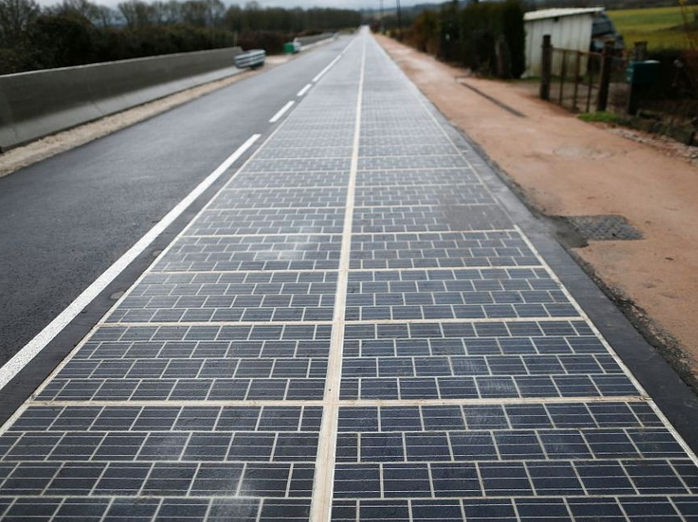
It’s said that it’s folly to judge the past with the mindset of the present. Just as we scoff at those who take pills to mask one illness while giving rise to another, future generations may scoff at our wasteful asphalt highways. The future — according to the French town of Tourouvre — is the solar highway, self-sustaining highways built from mosaics of solar cells.
The small Normandy town of Tourouve inaugurated the world’s first “solar highway” this past December 21st , a one-kilometer stretch of highway covered with 2,800 square meters of resin-coated photovoltaic solar panels. The solar panels are linked to the local power grid and provide enough power to sustain all of Tourouvre’s streetlights.
“Wattway,” the name of the solar road tech, was developed and built by Colas, a large Anglo-French construction company. The project spanned five years of research and multiple tests conducted in car parks, but the road outside Tourouve is the first active road implementing the Wattway. A two-year test period now comes under effect to see if Wattway can withstand the stress of the 2,000 or so vehicles that use the Tourouvre road each day.
Each panel contains a 15-centimeter-wide cell made from a very thin film of polycrystalline silicon responsible for converting the solar energy into electricity. A multilayer substrate of “resin and polymers” coats cells to enhance durability while adapting to the road’s natural contours. Electrical system wiring drawn from the cells may be linked up on the side of traffic lanes, in gutters, or in ducts built into the panels themselves.

A similar idea is also underway in Germany, the Netherlands, and the United States with the idea being that vehicles occupy roadways only 20% of the time (in certain parts of the country), providing huge surface areas to soak up the sun’s beams.
“This new use of solar energy takes advantage of large swathes of road infrastructure already in use … to produce electricity without taking up new real estate,” said Environment Minister Segolene Royal in a statement. The initiative is the prototype of a four-year plan for national deployment, beginning with the western region of Brittany and southern Marseille.
Sounds great in theory, but what’s the catch? Well, the kilometer-long road cost nearly €5 million to build — and that’s in a single lane.
Skeptics also argue that “solar highways” lack the efficiency needed to justify the investment. In 2014, a similar 70-meter solar bicycle path was built in the suburbs of Amsterdam at the cost of €3 million and generated a mere 3,000 kilowatt-hours of electricity within its first year — enough to power a single home. Ars Technica’s Sebastian Anthony points out that at the current wholesale price in the UK, about £40 per megawatt-hour, €3 million could have procured 65,000,000 kilowatt-hours of electricity, or enough energy to power 21,000 homes for an entire year.
According to the Colas’ brochure , 20 square meters supplies enough power for a single home. Therefore, 2,800 meters should power 140 homes. Considering the 2,800-m stretch will power streetlights, such output seems questionable.
At the same time, Colas believes that France could become energy-independent by paying only a quarter of its million kilometers of roads with solar panels.
Royal seconds these sentiments, but maintains a goal grounded in reality: she’d like to replace one kilometer of asphalt for every 1,000 km. Assuming two lanes of a single kilometer cost €10 million, then the total cost should sit around €10 billion — a reasonable cost, assuming that the Wattway doesn’t depend on routine maintenance and successfully produces enough energy to offset the initial investment.
Source: Phys.org and Ars Technica
Advertisement
Learn more about Electronic Products Magazine





